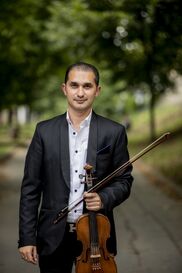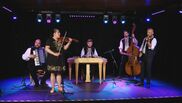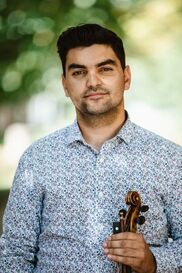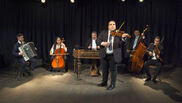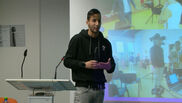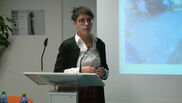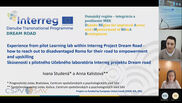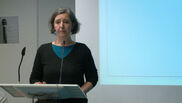Kristián Bandy
created: 02. 10. 2023 11:10 modified: 27. 10. 2023 13:33
Bc. Kristian Bandy, Dis.art plays viola in the family cimbalom band Dusi Band. He is a visiting member of the music section of the Romathan Theater, he conducts the music band of the Folklore Ensemble Fijalecka at the Elementary School Srobarova in Presov. He is a graduate of the Mikulas Moyzes Elementary Art School in Presov, violin major. He continued his studies at the Dezider Kardoš Private Conservatory in Prešov (1st - 3rd year), and graduated from the Private Music and Dramatic Conservatory in Košice (4th - 6th year).
He received his bachelor's degree at the Catholic University in Ružomberok, workplace in Spišské Podhradie.
The photos show the brothers Kristián and Július Bandy Jr.
The photos were taken as part of documenting family cimbalom bands in 2022.
category: fine arts
tags: secular digital artistic in persona photography Kristián Bandy general audience internal
Samuel Bandy
created: 02. 10. 2023 11:01 modified: 27. 10. 2023 13:31
Samuel Bandy is the leading violinist of the family cimbalom band Ďusi Band. Graduated from the Mikulas Moyzes' Elementary School of Arts in Presov, he is currently a student of the Conservatory, Timonova street 2, Kosice. He won several significant awards from various competitions of violin players in Slovakia.
The photos were taken during documentation of the family cimbalom bands in 2022.
category: fine arts
tags: secular digital artistic in persona photography Samuel Bandy general audience internal
Daje, daje - Štefan Cína and the Folk Band
created: 28. 08. 2023 16:53 modified: 28. 08. 2023 16:54
The Romani folk song, recorded on July 8, 2022 as part of the series Documentation of Romani Cimbalom Folk Bands in Slovakia. It’s a dance song in fast tempo, the traditional Romungro czardasz. The Cínas (the siblings Štefan – accordion, Martina – violin, vocals) learned the song at home from their father, who learned it from his father. The lyrics of the song is in the Romani language.
category: music
tags: vocal-instrumental modern folk quintet borrowed Romani Štefan Cína's Folk Music Band general audience internal
The Manusha
created: 21. 08. 2023 14:53 modified: 27. 10. 2023 13:18
The Manusha (People) is the music band in which the professional musicians play, the project being initiated by a Slovak singer Júlia Kozáková. Ľubomír Gašpar plays a cimbalom, Viliam Didiáš plays a violin, Vojtech Bélu Botoš plays a viola and Ján Rigo plays a double-bass. With financial support of the Fund for minority culture SR and The Bratislava Self-Governing Region the band released the album with the same title. Ten compositions are the traditional Romani songs arranged specifically by the band's members, introducing also elements of the Hungarian Romani music.
The photos were taken during documenting The Manusha band as a part of the project of documentation of the Romani family cimbalom bands.
category: fine arts
tags: secular digital artistic in persona photography The Manusha general audience internal
Daniel Pokoš
created: 21. 08. 2023 14:28 modified: 27. 10. 2023 13:06
He was born into the musical family in Telgart, since his early childhood he was interested in playing various instruments. He plays primarily the violin. He learnt to play the violin by himself, never attending any musical school. He gained musical experience by playing in his own band as well as in the Pokosovci Band.
The photos were taken during documenting the Pokos Band as a part of the projec of documentation of the Romani family cimbalom bands.
category: fine arts
tags: secular digital artistic in persona photography Daniel Pokoš general audience internal
Friš Czardas - The Július Žiga Folk Band
created: 03. 07. 2023 23:03 modified: 03. 07. 2023 23:07
The family cimbalom band called The Folk Band of Július Žiga consists of father Július, his daughter Bohdana and his son Filip. The family comes from the town of Gelnica and keeps alive the tradition of folk Romani music. All three of them received a classical music education, they are excellent performers of a genre-rich repertoire that includes Romani and partially also Slovak folklore.
Instrumental cast:
Július Žiga – double bass, Bohdana Žigová – cello, vocals, Filip Žiga – violin, Július Bandy (guest) – cimbalom, Kristián Bandy (guest) – viola, Vladimír Plachetka (guest) – accordion.
The istrumental composition, the band leader Július Žiga doesn't know its title, or the author, the coposition is traditionally played by the Romani bands, the czardas is played in brisk tempo, so called friss czardas.
The recording was created on 11/12/2021 at the Center of Independent Culture Wave in Prešov.
category: music
tags: instrumental modern folk sextet borrowed The Folk Band of Július Žiga general audience internal
Roman Šana: Teaching Roma Digital Competences in Luník IX.
created: 22. 05. 2023 11:00 modified: 22. 05. 2023 11:01
The third year of the conference titled The Current State of Romani Studies III; the organizer was the State Scientific Library in Prešov, a documentation and information center of Romani culture. The Center of Social and Psychological Sciences of the Slovak Academy of Sciences and the Institute of Roma Studies of the Prešov University in Prešov collaborated. It was held on 1-2 December 2022 at the University of Prešov. The hybrid form enabled the participation of scientists from abroad as well. There were 23 contributions in five panels.
In the Luník IX panel, the facilitator of the Learning Lab project, Roman Šana, a high school student, presented his practical experience in educating adults in the field of digital skills. The video was recorded on December 2, 2022.
category: speaking
tags: academic report monologue conference Slovak Roman Šana academic audience internal
Bc. Petra Kurutzová: Improving the Digital Skills of Adults/Dream Road-Learning Lab in Luník IX
created: 22. 05. 2023 10:59 modified: 22. 05. 2023 11:00
The third year of the conference titled The Current State of Romani Studies III; the organizer was the State Scientific Library in Prešov, a documentation and information center of Romani culture. The Center of Social and Psychological Sciences of the Slovak Academy of Sciences and the Institute of Roma Studies of the Prešov University in Prešov collaborated. It was held on 1-2 December 2022 at the University of Prešov. The hybrid form enabled the participation of scientists from abroad as well. There were 23 contributions in five panels.
In the Luník IX panel, Bc. Petra Kurutzová, ETP Slovakia – Center for Sustainable Development presented the project Dream Road: Learning Lab and its activities. The video was recorded on December 2,2022.
category: speaking
tags: academic report monologue conference Slovak Alexandra Kuruczová academic audience internal
Ing. Ivana Studená, PhD., Ing. Anna Kalistová, PhD.: Experiences from the Pilot Learning Lab within the Interreg Project: Dream Road - How to Reach Disadvantaged Roma on the Way to Their Empowerment and Increased Qualification
created: 22. 05. 2023 10:54 modified: 22. 05. 2023 10:55
The third year of the conference titled The Current State of Romani Studies III; the organizer was the State Scientific Library in Prešov, a documentation and information center of Romani culture. The Center of Social and Psychological Sciences of the Slovak Academy of Sciences and the Institute of Roma Studies of the Prešov University in Prešov collaborated. It was held on 1-2 December 2002 at the University of Prešov. The hybrid form enabled the participation of scientists from abroad as well. There were 23 contributions in five panels.
In the panel Luník IX spoke: Ing. Ivana Studená, PhD., from the Prognostic Institute CSPV SAV, v.v.i. and Ing. Anna Kalistová, PhD. from the Institute of Social Sciences CSPV SAV, v.v.i. . The paper is titled Experiences from the Pilot Learning Lab within the Interreg Project: Dream Road - How to Reach Disadvantaged Roma on the Way to Their Empowerment and Increased Qualification. The video was recorded on December 2, 2022.
category: speaking
tags: academic report monologue conference Slovak Ivana Studená Anna Kalistová academic audience internal
Mgr. Karolína Ryvolová, Ph.D.: Reckoning Time. Contemporary Czech Romani Literature between Social Defense and Attack
created: 22. 05. 2023 10:50 modified: 22. 05. 2023 10:51
The third year of the conference titled The Current State of Romani Studies III; the organizer was the State Scientific Library in Prešov, a documentation and information center of Romani culture. The Center of Social and Psychological Sciences of the Slovak Academy of Sciences and the Institute of Roma Studies of the Prešov University in Prešov collaborated. It was held on 1-2 December 2022 at the University of Prešov. The hybrid form enabled the participation of scientists from abroad as well. There were 23 contributions in five panels.
In the Language, Literature and Media Environment panel, Mgr. Katarína Ryvolová, Ph.D. from the Kher Publishing House, Prague, Czech Republic, presented a contribution titled Reckoning Time. Contemporary Czech Romani Literature between Social Defense and Attack. The video was recorded on December 2, 2022.
category: speaking
tags: academic report monologue conference Czech Karolína Ryvolová academic audience internal




